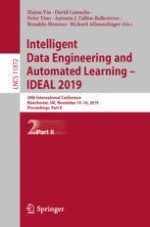This two-volume set of LNCS 11871 and 11872 constitutes the thoroughly refereed conference proceedings of the 20th International Conference on Intelligent Data Engineering and Automated Learning, IDEAL 2019, held in Manchester, UK, in November 2019.
The 94 full papers presented were carefully reviewed and selected from 149 submissions. These papers provided a timely sample of the latest advances in data engineering and machine learning, from methodologies, frameworks, and algorithms to applications. The core themes of IDEAL 2019 include big data challenges, machine learning, data mining, information retrieval and management, bio-/neuro-informatics, bio-inspired models (including neural networks, evolutionary computation and swarm intelligence), agents and hybrid intelligent systems, real-world applications of intelligent techniques and AI.
